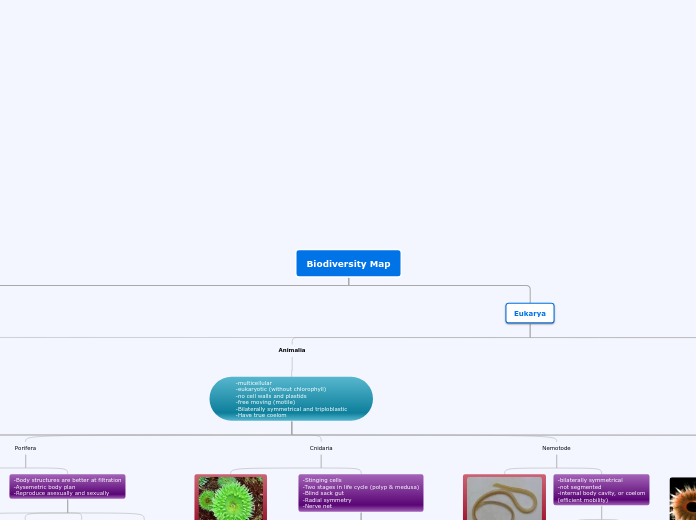Biodiversity Map
Archaea
-Single celled microorganism
-Similar structure as bacteria
-Prokaryote
-Reproduce asexually
-Different DNA structure than
bacteria
Archaeabacteria
-Cell membrane contains lipids
-Flourish in the absence of Oxygen
-Rigid cell wall
-Reproduce asexually (binary fission)
Methanobrevibacter
-Found in human gut
-Cocci shape
-Consumes end products of
bacterial fermentation
Bacteria
-lack of membrane-
bound organelles
-unicellular (single celled)
-Prokaryote
-DNA found in plasmids
Eubacteria
-Unicellular
-Prokaryotes
-Cell membrane contains lipids
-Chromosome are circular
Bacillus
Coccus
Spirillum
Eukarya
Protista
-Usually single celled
-Eukaryotic organism
-Heterotrophs + Autotrophs
-Digest food outside of the
body cavity
Plant-like
-Photosynthesis
-Chloroplast
Euglenophytes
Euglena gracilis
Chrysophytes
Golden Algae
Diatoms
Skeletonema costatum
Dinoflagellates
Lingulodinium polyedra
Animal-like
-Encircle prey and wraps around
to engulf
-Lysosomes break down the food
Amoeba-like protists
-Locomotion using light
sensing organ
-Use pseudopodia to pull
themselves forward
Naegleria fowleri
Flagellates
-Use flagellum by
rotate/whip
Pentatrichomonas hominis
Ciliates
-Tiny cilia beat to
move through water
Paramecium caudatum
Spore-forming protists
-contraction of intracellular
microfilaments
Nephridiophaga blaberi
Fungus-like
-Decompose dead matter
to make energy
-Absorb nutrients
Oomycota
Potato late blight fungus
Myxomycota
Physarum polycephalum
Chytridiomycota
Synchytrium endobioticum
Dictyostelida
Polysphondylium
Animalia
-multicellular
-eukaryotic (without chlorophyll)
-no cell walls and plastids
-free moving (motile)
-Bilaterally symmetrical and triploblastic
-Have true coelom
Mollusca
-bilateral symmetry
-Unsegmented soft body with bilateral symmetry
-Presence of an internal or external shell
-A toothed tongue (made mostly of chitin) called the radula
-A mantle which is a fold in the body wall that lines the shell
-Muscular foot (and/or tentacles in some).
-Possession of a fluid-filled cavity (coelom)
Gastropods
Bivalves
Cephalopods
Pacific oyster
Arthopods
-chitinous exoskeleton
-jointed/segmented appendages
-a well-developed head and mouthparts
-striated muscles
-open circulatory system
-dorsal heart.
Myriapoda
Chilopoda
Chilopoda
Diplopoda
Symphyla
Pauropoda
Chelicerates
Ixodida
Arachnida
Solifugae
Merostomata
Eurypterida
Pycnogonida
Pycnogonida
Hexapoda
Blattodea
Collembola
Diplura
Insecta
Protura
Crustacea
Nephropidae
Branchiopoda
Malacostraca
Maxillopoda
Ostracoda
Silverfish
Platyhelminthes
-3 germ layers
-bilateral symmetry
-primitive nervous system
Turbellaria
Monogenea
Trematoda
Cestoda
Tapeworms
Porifera
Spongilla lacustris
-Body structures are better at filtration
-Aysemetric body plan
-Reproduce asexually and sexually
Calcarea
Demospongiae
Hexactinellida
Homoscleromorpha
Cnidaria
Giant Green Anemone
-Stinging cells
-Two stages in life cycle (polyp & medusa)
-Blind sack gut
-Radial symmetry
-Nerve net
Scyphozoa
Hydrozoa
Cubozoa
Anthozoa
Nemotode
Ascaridida
-bilaterally symmetrical
-not segmented
-internal body cavity, or coelom
(efficient mobility)
Enoplea
Chromadorea
Annalid
Polychaeta
Oligochaetes
Hirudinea
-segmented body
-tiny hair-like bristles on their outer surface called setae or chaetae
-segmentation
-well-developed body cavity.
Chordate
Chimpanzee
-a notochord (a cartilaginous skeletal
rod supporting the body)
-a dorsal hollow nerve cord
-pharyngeal slits
-post-anal tail.
Tunicata
Cephalochordates
Vertebrate
Agnathans
Chondrichthyes
Osteichthyes
Amphibia
Gnathostomata
Reptilia
Aves
Mammalia
Marsuplials
-Live births
-Incompletley developed fetus'
-Finish developing in pouch
Marsupials>Monotremes
-Live births instead of eggs
Monotremes
-Lay eggs
-Incubate in nest or
special pouch
Placentals
-Retain young in uterus
for a long time of the development
-nourished by placenta
Placentals>Marsupials
-a fetus is born smaller+less mature without placenta
-can't grow because nutrients received are limited
Echinodermata
Sea Urchin
Red sea Urchin
- bilateral symmetry (five-sided symmetry)
-echinoderm larvae are ciliated, free-swimming organisms that organize in bilateral symmetry
-They have a true coelom.
Sea star
Sea Cucumbers
Crinoids
Plantae
-Multi-cellular
-eukaryotic
-Autotrophic
-Cell walls of cellulose
-Store food as starch
-Develop from embryos
-Live primarily in terrestrial
environments although there are exceptions
Bryophytes
-waxy cuticle
-gametangia
Marchantiophyta
Crescent-cup liverwort
Anthocerotophyta
Phaeoceros laevis
Bryophyta
Common liverwort
Seedless Vascular
-true roots
-waxy cuticle
-vascular tissue
Pterophyta
Eagle fern
Sphenophyta
Field horsetail
Lycophyta
Stag's-horn clubmoss
Psilotophyta
Whisk Fern
Gymnosperms
-seed plants with a protected
cone over seed
Coniferophyta
Giant sequoia
Cycadophyta
Sago palm
Gingkophyta
Maidenhair tree
Gnetophyta
Melinjo
Angiosperms
-utilize flowers to attract
pollinators
monocots
lilies
dicots
Mint
Fungi
-Non-motile
-Cell walls made of Chitin
-Eukaryotic
-Heterotrophs (absorb food from outside)
-Symbiotic relationships
-Spores (single reproductive cell that is released)
-Sexual and asexual reproduction
Chytridiomycota
-Zoospores attach and
feed off host
Batrachochytrium dendrobatidis
Zygomycota
-Zygospores following
gametangial fusion
Rhizopus stolonifer
Ascomycota
-fungus undergoes
budding or fission
Cordyceps
Basidiomycota
-budding or asexual
spore formation
Calvatia gigantea
